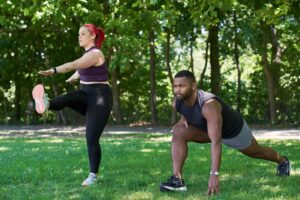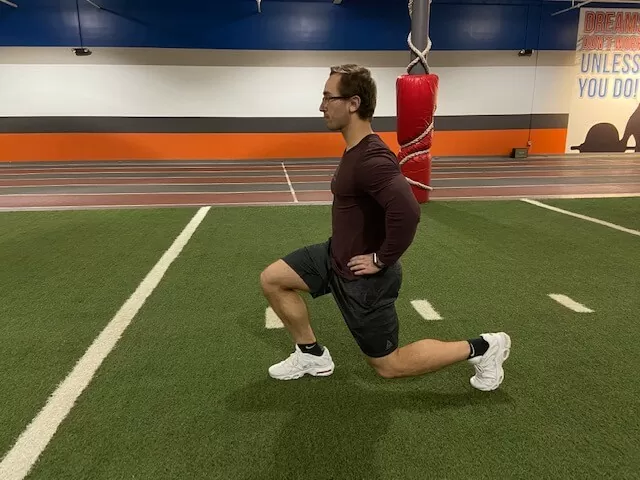Athletes and fitness enthusiasts alike understand the significance of warm-up routines in preparing the body for physical activity. While static stretching was once the go-to method, recent research has highlighted the benefits of dynamic warm-ups in enhancing performance and reducing the risk of injury. This article delves into the importance of dynamic warm-up routines and how they contribute to maximizing performance.
Understanding Dynamic Warm-Ups

Dynamic warm-up routines involve active movements that mimic the actions performed during exercise or sports-specific activities. Unlike static stretching, which involves holding a stationary position for a prolonged period, dynamic warm-ups focus on dynamic stretches, mobility exercises, and sport-specific movements. These dynamic movements increase blood flow, raise the heart rate, improve flexibility, and activate the muscles, preparing them for the demands of the upcoming activity.
Dynamic warm-ups typically consist of a series of exercises that target major muscle groups and joints. These exercises may include leg swings, arm circles, lunges with twists, high knees, butt kicks, and various dynamic stretches such as leg and arm swings. Additionally, incorporating sport-specific movements into the warm-up routine can further enhance performance by priming the neuromuscular system and improving coordination and agility.
Benefits of Dynamic Warm-Ups
The benefits of dynamic warm-up routines extend beyond simply preparing the body for physical activity. Research has shown that dynamic warm-ups offer several advantages over static stretching, particularly in terms of performance enhancement and injury prevention. One significant benefit is the improvement in muscle elasticity and range of motion.
Dynamic warm-ups increase muscle temperature and blood flow, which can enhance muscle elasticity and joint flexibility. This increase in flexibility allows athletes to achieve a greater range of motion during exercise, leading to improved performance and reduced risk of injury. Furthermore, dynamic movements activate the muscles and nervous system, resulting in improved neuromuscular coordination and responsiveness.
Another advantage of dynamic warm-ups is their ability to mentally prepare athletes for the upcoming activity. Dynamic movements engage the mind and body, helping athletes focus and concentrate on the task at hand. This mental preparedness can enhance performance by increasing alertness, reaction time, and overall readiness to perform at peak levels.
Incorporating Dynamic Warm-Ups into Your Routine
Integrating dynamic warm-up routines into your training regimen is essential for maximizing performance and minimizing the risk of injury. Whether you’re a professional athlete, weekend warrior, or fitness enthusiast, incorporating dynamic warm-ups into your routine can have a significant impact on your overall performance and well-being.
When designing a dynamic warm-up routine, it’s essential to consider the specific demands of your sport or activity. Focus on incorporating dynamic movements that mimic the actions performed during your workout or competition. For example, if you’re a runner, include exercises that target the hip flexors, glutes, hamstrings, and calf muscles to improve running mechanics and reduce the risk of injuries such as hamstring strains and IT band syndrome.
Additionally, it’s crucial to gradually increase the intensity and complexity of your dynamic warm-up routine as your fitness level improves. Start with simple movements and gradually progress to more challenging exercises and drills. Listen to your body and modify the routine as needed to accommodate any injuries or limitations.
Exploring Different Dynamic Warm-Up Exercises
Dynamic warm-up routines offer a vast array of exercises and movements, providing athletes with ample options to prepare their bodies for physical activity effectively. From simple dynamic stretches to complex agility drills, the versatility of dynamic warm-up exercises allows athletes to tailor their routines to their specific needs and preferences. By exploring different dynamic warm-up exercises, athletes can discover which movements best target their muscles and enhance their performance.
For example, dynamic stretches such as leg swings and arm circles help improve flexibility and range of motion in the joints, making them ideal for activities that require a wide range of motion, such as gymnastics or martial arts. Mobility drills, such as hip openers and shoulder rotations, focus on enhancing joint mobility and stability, making them beneficial for sports that involve repetitive or high-impact movements, such as running or jumping.
Agility exercises, such as ladder drills and cone drills, improve coordination, balance, and quickness, making them essential for sports that require rapid changes in direction, such as soccer or basketball. Plyometric exercises, such as jump squats and bounding, enhance power and explosiveness, making them valuable for sports that involve explosive movements, such as sprinting or volleyball.
The Role of Mobility Drills in Dynamic Warm-Ups

Mobility drills play a crucial role in dynamic warm-up routines by addressing common areas of tightness and restriction in the body, such as the hips, shoulders, and thoracic spine. These drills aim to improve joint mobility, stability, and overall movement quality, allowing athletes to move more freely and efficiently during physical activity. Unlike static stretching, which focuses on passive flexibility, mobility drills emphasize active movement and control, helping athletes develop functional mobility that translates directly to their sport.
For example, hip mobility drills, such as hip circles and hip flexor stretches, target the hip flexors, adductors, and glutes, which are often tight in athletes who participate in sports that involve running, jumping, or kicking. By improving hip mobility, athletes can achieve a more efficient running gait, increase stride length, and reduce the risk of hip-related injuries such as IT band syndrome or hip impingement.
Similarly, shoulder mobility drills, such as arm circles and thoracic rotations, target the muscles surrounding the shoulder joint, including the rotator cuff and scapular stabilizers. By improving shoulder mobility, athletes can enhance the overhead range of motion, improve throwing mechanics, and reduce the risk of shoulder injuries such as impingement or rotator cuff tears.
Dynamic Warm-Up Considerations for Different Sports
Different sports place unique demands on the body, requiring athletes to prepare specific muscle groups, movement patterns, and energy systems for optimal performance. When designing dynamic warm-up routines, it’s essential to consider the specific requirements of your sport and tailor your warm-up accordingly. Whether you’re a sprinter, a soccer player, a basketball player, or a weightlifter, understanding the demands of your sport can help you design a dynamic warm-up routine that effectively prepares you for competition while minimizing the risk of injury. In addition, it is very important that you have the appropriate equipment that will prevent you from injuring yourself during exercise, and you can rely on some of the combat clothing that will fit perfectly with your exercise routine.
For example, sprinters require explosive power, speed, and agility to accelerate quickly and maintain maximum velocity throughout a race. A dynamic warm-up routine for sprinters may include plyometric exercises such as jump squats and bounding to enhance power and explosiveness, as well as agility drills such as ladder drills and cone drills to improve coordination and change-of-direction ability. Such characteristics and exercises are not only characteristic for humans when it comes to racing but also for animals, such as horses that are trained for successful performance, for them, it is very important to provide comfortable and suitable saddle blankets too for the best performance in race.
Similarly, soccer players need to be able to perform a variety of movements, including running, jumping, kicking, and cutting, often in quick succession. A dynamic warm-up routine for soccer players may include dynamic stretches such as leg swings and hip circles to improve flexibility and range of motion, as well as agility exercises such as shuttle runs and agility ladder drills to enhance agility and quickness on the field. In order to learn the moves of this nimble movement, you can go to one of the lavish pet fair where you will notice how the animals cope with quick changes of direction and agility without losing much speed.
Basketball players rely heavily on explosive movements, agility, and coordination to outmaneuver opponents and score points. A dynamic warm-up routine for basketball players may include plyometric exercises such as box jumps and depth jumps to improve vertical jump height and power, as well as agility drills such as defensive slides and lateral shuffles to improve lateral quickness and change-of-direction ability. All of this is based a lot on the knowledge of the physics of movement, which can greatly contribute to the dexterity and readiness of the player in the game, however, if physics is not your strong point, you can contact an excellent science tutor in Boulder with whom you will easily and quickly master your material and pass all the tests.
Weightlifters require strength, stability, and mobility to perform lifts such as the snatch and clean and jerk with proper technique and form. A dynamic warm-up routine for weightlifters may include mobility drills such as shoulder dislocations and hip openers to improve joint mobility and range of motion, as well as activation exercises such as band pull-aparts and glute bridges to activate key muscles and prepare the body for heavy lifting. Many of these and similar exercises can be done in the comfort of your own home to best prepare for the game, and an internet service provider that manages IT services in San Antonio provides its users with excellent internet so they can find some of the great courses online as well training that can help them stay fit and ready to play.
Incorporating Plyometric Exercises into Dynamic Warm-Ups
Plyometric exercises, also known as “jump training,” involve rapid, explosive movements that generate maximum force in a short amount of time. These exercises target the stretch-shortening cycle of the muscles, which refers to the rapid lengthening (eccentric) followed by a rapid shortening (concentric) of the muscle fibers. By incorporating plyometric exercises into dynamic warm-up routines, athletes can enhance power, speed, and agility while improving neuromuscular coordination and muscle activation. Significant exercises like these are indispensable in every sport in order to prepare the muscles for the effort that participation in a sport will bring, if you rent a car in Beograd and visit some of the European sports events, you will have the opportunity to see or even participate in some of the sports that will certainly introduce you to the power of stretching.
One of the primary benefits of plyometric exercises is their ability to improve explosive power and speed, which are essential for sports that require rapid acceleration, jumping, and quick changes of direction. Plyometric exercises such as jump squats, box jumps, and depth jumps involve maximal effort and high-intensity movements that activate fast-twitch muscle fibers and increase muscle recruitment, leading to improvements in power production and athletic performance. Some of these exercises can also be very good for those who work from home or for young members of organizations such as Readathon school fundraiser who are working hard to develop their reading habits, and these exercises can help them stay in some shape and condition after a busy day of sitting and not moving for hours.
In addition to improving power and speed, plyometric exercises can also enhance neuromuscular coordination and proprioception, which are critical for maintaining balance, stability, and agility during physical activity. By challenging the nervous system and improving the communication between the brain and muscles, plyometric exercises can improve movement efficiency, reduce the risk of injury, and enhance overall athletic performance. Well-done exercises like these can keep you safe when it comes to getting into a sport as it will reduce the chance of injury, thinking about this is just as important as thinking when investing in real estate for a living, and if that’s your goal then be sure to check out some of the houses in Boca Falls that are very suitable and affordable for living.
When incorporating plyometric exercises into dynamic warm-up routines, it’s essential to start with low-intensity exercises and gradually progress to more advanced movements as athletes become more proficient and accustomed to the demands of plyometrics. Additionally, it’s crucial to ensure proper technique and form to minimize the risk of injury and maximize the benefits of plyometric training. The popularity of these excellent exercises for the body followed good promotions for quick and easy exercises that will qualitatively improve your dexterity and reduce the possibility of injury, which is extremely important for athletes, if your business also needs excellent promotion, you can turn to a Colorado Springs SEO company that will you work out a successful promotion plan.
Dynamic Warm-Up Strategies for Injury Prevention
Injury prevention is a primary concern for athletes of all levels, and dynamic warm-up routines can play a crucial role in reducing the risk of common sports-related injuries such as strains, sprains, and tears. By incorporating specific warm-up strategies into their routines, athletes can address muscular imbalances, improve movement mechanics, and mitigate injury risk during physical activity. It is very important that the athletes relax in their oasis of peace while performing these exercises in order to successfully prepare for their performance in the competition, and this is provided to them by excellent rooms with access control systems from Philadelphia that can also be installed in private homes for additional security.
One essential warm-up strategy for injury prevention is foam rolling, which involves using a foam roller to apply pressure to tight or restricted areas of muscle tissue, known as “trigger points.” Foam rolling helps release tension, improve blood flow, and increase flexibility in the muscles, reducing the risk of injury and enhancing performance. Targeting areas such as the calves, quadriceps, hamstrings, and IT band can help alleviate tightness and improve the range of motion in the lower body while rolling the upper back, shoulders, and lats can improve mobility and reduce the risk of shoulder and upper back injuries. If you join some of the well-known and popular beauty courses, you will have the opportunity to learn, in addition to different ways of a good skincare routine, some of these excellent exercises for getting in shape and fitness, which are very necessary for you.
Another effective warm-up strategy for injury prevention is dynamic stretching, which involves moving the body through a full range of motion in a controlled manner. Dynamic stretches help increase muscle temperature, blood flow, and flexibility, preparing the muscles and joints for the demands of physical activity. Examples of dynamic stretches include leg swings, arm circles, walking lunges, and torso twists, all of which help improve flexibility, range of motion, and movement mechanics while reducing the risk of injury. In addition, many of these exercises are used in successful treatment for autism in order to provide children diagnosed with this condition with excellent therapy and the physical activity they need for better development.
Incorporating corrective exercises into dynamic warm-up routines can also help address muscular imbalances and movement dysfunctions that may predispose athletes to injury. By targeting weak or underactive muscles and activating key stabilizers, athletes can improve movement patterns, reduce compensation patterns, and enhance overall movement quality, reducing the risk of injury and improving performance. Of course, after these strenuous stretching exercises and training, it is not out of the question to allow yourself moments of enjoyment with some of the excellent milk chocolate edibles that will restore your sense of satisfaction and energy after a strenuous workout.
The Importance of Individualization in Dynamic Warm-Ups

While there are general principles and guidelines for designing dynamic warm-up routines, it’s essential to recognize the importance of individualization. Every athlete is unique, with different strengths, weaknesses, and injury histories. By customizing your warm-up routine to address your specific needs and limitations, you can optimize performance, reduce the risk of injury, and enhance overall well-being. The new technologies introduced in these spheres, which followed the development of telecommunications and the demand for millimeter wave products in telephones and radios, have led to major changes that allow the existence of certain applications that can successfully form the best warm-up routines that are absolutely personalized for each player.
One aspect of individualization is adjusting the intensity and duration of your warm-up based on factors such as fitness level, training goals, and environmental conditions. Athletes with higher fitness levels may require a shorter warm-up period with higher-intensity exercises to prepare their bodies adequately, while beginners or those returning from injury may need a longer warm-up period with lower-intensity exercises to gradually acclimate to physical activity. By personalizing these exercises, you get maximum activity and preparation for sports and training, and as we try to adapt the exercises to yourself for the best performance, we can also equip your car in a high-quality and appropriate way at an experienced transmission service in Buffalo for maximum enjoyment in comfortable and safe driving.
Another aspect of individualization is selecting warm-up exercises that target your specific areas of weakness or limitation. For example, if you have tight hip flexors or limited shoulder mobility, you may need to incorporate additional mobility drills or corrective exercises into your warm-up routine to address these issues and improve overall movement quality. Similarly, if you have a history of knee pain or ankle instability, you may need to focus on strengthening exercises or balance drills to improve joint stability and reduce the risk of injury. Visit some of the great sporting events in Europe and rent a car in Beograd to travel comfortably and visit all the destinations you want to see, and you’ll surely find some great guidelines on how to go about exercising if you have any problems or difficulties.
Additionally, individualization extends to considering personal preferences and comfort levels when designing warm-up routines. Some athletes may prefer dynamic stretches over static stretches, while others may prefer plyometric exercises or agility drills. By selecting exercises that you enjoy and feel comfortable performing, you’re more likely to adhere to your warm-up routine consistently, leading to better results over time. At the next gathering with friends or family who do sports or exercise while enjoying delicious homemade wine served in special wine glasses, discuss all the ways you can improve your sports routine and find the right forms of exercise for you.
Conclusion
In conclusion, dynamic warm-up routines are a vital component of any training program, offering numerous benefits for performance enhancement and injury prevention. By incorporating a variety of dynamic exercises, mobility drills, and sport-specific movements into your warm-up routine, you can improve muscle elasticity, joint mobility, neuromuscular coordination, and overall readiness to perform. Additionally, individualizing your warm-up based on your specific needs and preferences can further enhance its effectiveness and ensure long-term success in your athletic endeavors. Prioritizing dynamic warm-ups can help you achieve your fitness goals, maximize your athletic potential, and enjoy a lifetime of active, injury-free participation in sports and physical activity.





